Season in Review 2022–23
Indices of duck populations, habitat conditions, and winter weather
Indices of duck populations, habitat conditions, and winter weather
By Mike Brasher, PhD, Senior Waterfowl Scientist, Ducks Unlimited, Inc. & Steve Adair, PhD, Chief Scientist, Ducks Unlimited, Inc.
This report describes duck breeding populations, habitat conditions, and broad-scale indices of weather as they may have affected regional duck abundance and hunting opportunities during the 2022–23 waterfowl season. Entering spring 2022, breeding habitat conditions and expectations for duck production in the Dakotas and southeastern Canadian prairies were vastly improved thanks to a series of late-winter and spring storms. In contrast, Montana and the western Canadian prairies continued to show signs of drought with pond numbers near or slightly below historical averages.
Federal and state biologists completed the Waterfowl Breeding Population and Habitat Survey in 2022 for the first time since 2019. Results from the survey revealed much as was expected given prior years of extreme drought—34.2 million ducks in the Traditional Survey Area, a 12% decline from 2019 and down 4% from the long-term average. Continuation of a multi-year drought in the western U.S. constrained local duck production, while wetland conditions from Alaska to the boreal forest made for another year of stable production. Anecdotal reports from hunters and biologists supported the overall expectation of increased production and a greater percentage of young birds in the fall flight, although local exceptions were noted. As summer turned to fall, widespread drought from California to Mississippi was the dominant theme, limiting habitat availability in major migration and wintering regions and favoring hunters with access to managed water. Mild temperatures through October provided extended hunting opportunities for northern tier states but led to lackluster early season migration. Major winter storms in November and December blasted the Midcontinent and triggered significant bird movements to southern destinations, although overflying many drought-stricken areas. In the Atlantic flyway, the combination of above average temperatures, lack of snow, and below-average ice cover on the Great Lakes impaired major bird movements and made for generally slow hunting, although isolated reports of success emerged from areas along the Atlantic coast. Warm temperatures dominated areas east of the Rockies in January, while frequent rains and periodic bouts of cold eased the drought and created new habitats that moved birds and provided hunting opportunities for those previously limited by lack of water. In the western U.S., a series of atmospheric rivers dropped record rain and mountain snow in December and January that relieved the multi-year drought, although it came at the cost of life-threatening floods and lost hunting opportunities later in the season. Avian flu emerged as a cause of widespread illness and mortality among geese, although its impacts dissipated through December. Overall, the 2022–23 waterfowl season was considered average or slightly better than average, likely owing to improved duck production and periodic favorable weather, although localized exceptions were noted across the flyways. Looking ahead to the 2023 breeding season, improved water conditions in the western U.S. bodes well for local production, while residual water from 2022 and winter snow have portions of the Dakotas primed for another year of good to excellent production. To the north, additional moisture will be required to lift the western Canadian prairies from continued drought, while more stable habitats in Alaska and the boreal forest are expected to provide normal support for duck production.
Many factors combine to influence the abundance and distribution of waterfowl during fall and winter, including temperature, snow and ice cover, precipitation, habitat quality and quantity, fall population size (a function of breeding population and productivity), disturbance, and agricultural land use practices. These have been documented and discussed by numerous authors, including peer-reviewed scientific publications (Nichols et al. 1983, Schummer et al. 2010, Hagy et al. 2016) and popular magazine articles (Brasher 2019, Moorman 2019, Moorman 2020). Weather variables are among the most well studied and the only ones quantified in a manner that enables timely examination of how they may have influenced waterfowl distributions and hunting experiences.
This report provides a large-scale overview of biological and environmental conditions in the contiguous U.S. in 2022–23 and their potential influence on duck abundance and distribution during fall-winter. Notable among these are breeding habitat conditions, which are pivotal in determining productivity and the overall fall flight, as well as large-scale weather patterns and landscape conditions during September–January. During the non-breeding season, waterfowl movements can be southerly and northerly as well as east and west. The relative influence of these factors varies across space, time, and among waterfowl species. Descriptions herein are intended to be general in nature and are not definitive assessments of either the distribution of waterfowl at specific times and locations or the conditions that affected them.
Hosts Dr. Mike Brasher and Chris Jennings are joined by Dr. Heath Hagy, waterfowl ecologist for the U.S. Fish and Wildlife Service, for a deep dive into how this waterfowl season shaped up for Mississippi and Central Flyway hunters. The trio discuss the timeline of events from spring breeding habitat all the way through January and how changing conditions impacted specific regions. Hagy provides an in-depth perspective from the National Wildlife Refuges he surveyed throughout the season and points out key weather patterns that impacted waterfowl distribution.
Much to the relief of waterfowl hunters and managers across North America, 2022 saw the return of the Waterfowl Breeding Population and Habitat Survey for the first time since 2019. Survey results revealed the consequences of multiple years of prairie drought, including near historic drought in 2021. The total duck estimate from the Traditional Survey Area (TSA; Alaska to western Ontario and south into the Dakotas and Montana) was 34.2 million, down 12% from 2019 and 4% below the long-term average (Table 1). Numbers from the Eastern Survey Area (ESA; central Ontario eastward to Newfoundland and south to Maine) were upbeat, as the 6 most intensively surveyed duck species from that area totaled 4.5 million, a 10% increase from 2019 and similar to the long-term average (Table 2).
Results on the population status of individual species were largely mixed. From the TSA, species such as gadwall, green-winged teal, and northern shoveler were down substantially from 2019 but remained near or above their long-term averages, signifying continued healthy populations. Mallard and American wigeon dropped 25% below their 2019 estimates and 10–20% below their long-term average. However, blue-winged teal and redheads were 20–35% above both their 2019 estimates and long-term average. The most alarming result was delivered by northern pintail, which fell to its lowest number in the 67-year history of the survey, 21% below 2019 and now down 54% from its long-term average. In the ESA, mallards proved to be a bright spot, up 15% from the 2019 estimate and near its long-term average, while Great Lakes mallards continued their downward slide and are now 34% below the 1991–2021 average. Meanwhile, the effects of prolonged and extreme drought in California and the Intermountain West continued to suppress local duck populations, with breeding mallards in California 31% below their long-term average.
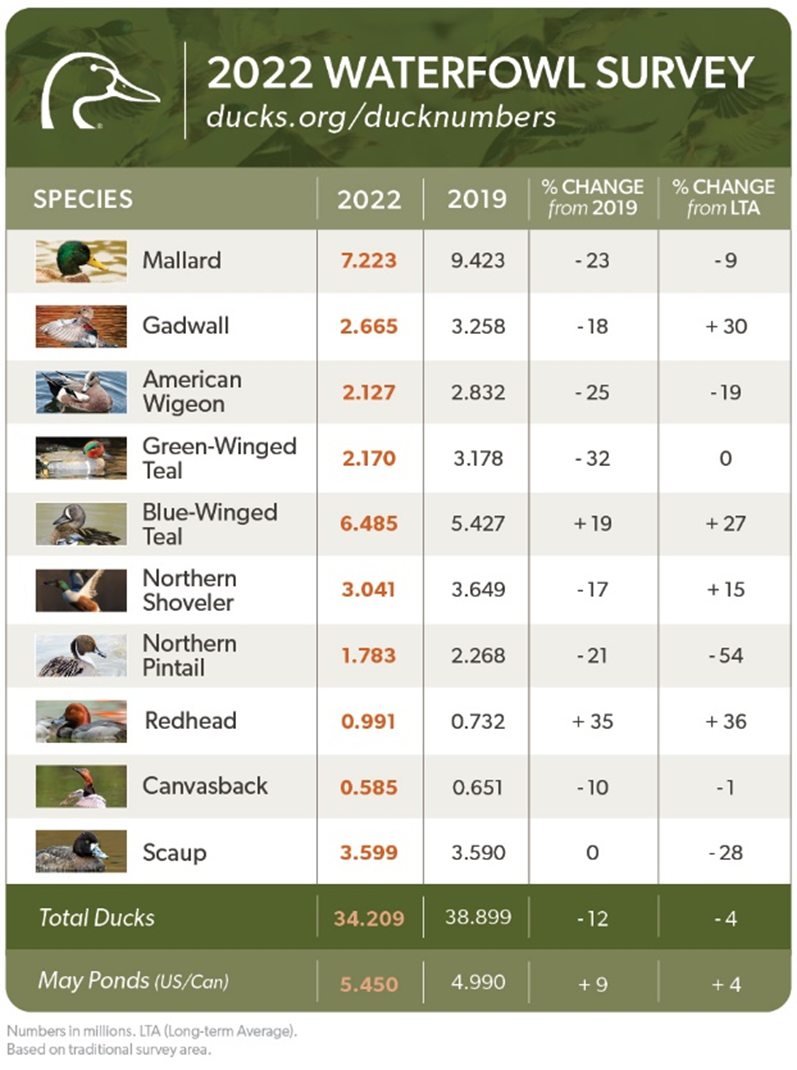
Table 1. Breeding population estimates for the 10 most common duck species in the Traditional Survey Area.
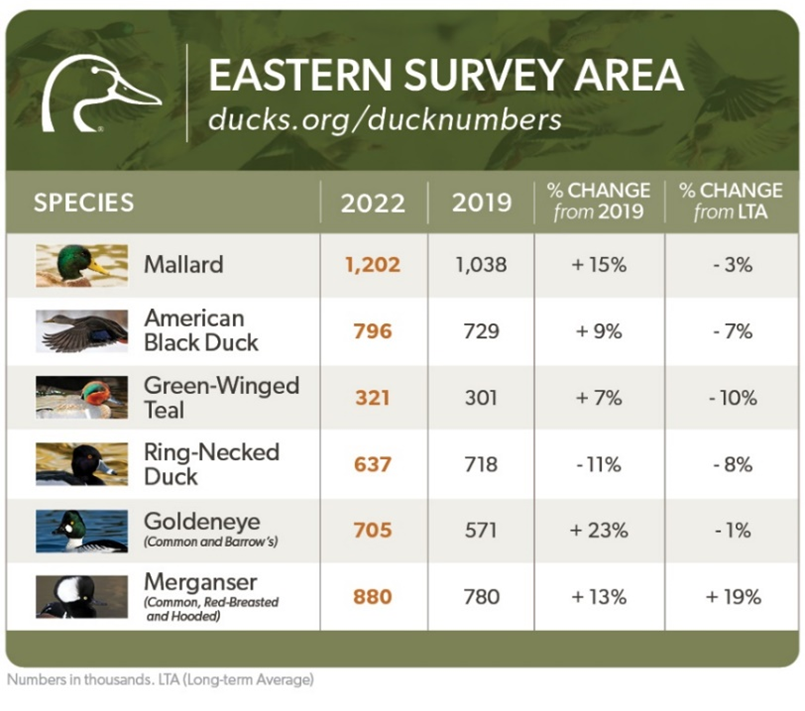
Table 2. Breeding population estimates for the 6 most common duck species in the Eastern Survey Area.
Prairie wetland conditions in 2022 were vastly improved over prior years, fueled by late winter snowstorms and spring blizzards that brought relief to the Dakotas, southern Manitoba, and southeastern Saskatchewan (Figure 1). The result was less severe drought and an abundance of recharged wetlands, as 5.45 million ponds were estimated across the U.S. and Canadian prairies, 4% above the long-term average. While the pond estimate was up only 9% over 2019, there is little doubt that it was a significant improvement over widespread drought of 2021. In fact, North Dakota's state-led duck survey reported a 600% increase in the water index from 2021 to 2022, the largest single-year change ever recorded on that survey. Wetlands in other survey regions are typically more stable over time, and this appears to have been the case once again. Much of the boreal forest and Alaska received above average snowfall and precipitation, with widespread reports of fair to excellent breeding habitat conditions. However, below-average temperatures in early spring delayed nesting efforts across many areas, constraining breeding opportunities at northern latitudes and contributing to later-hatched broods. Wetland conditions remained strong across the prairies through most of summer, likely encouraging abundant renesting and contributing to reports of late-hatched broods. Despite a below average breeding population, waterfowl managers expected good production from most areas in 2022, with the greatest improvements anticipated in the prairies, and reports from hunters and biologists in fall and winter were largely consistent with this expectation.
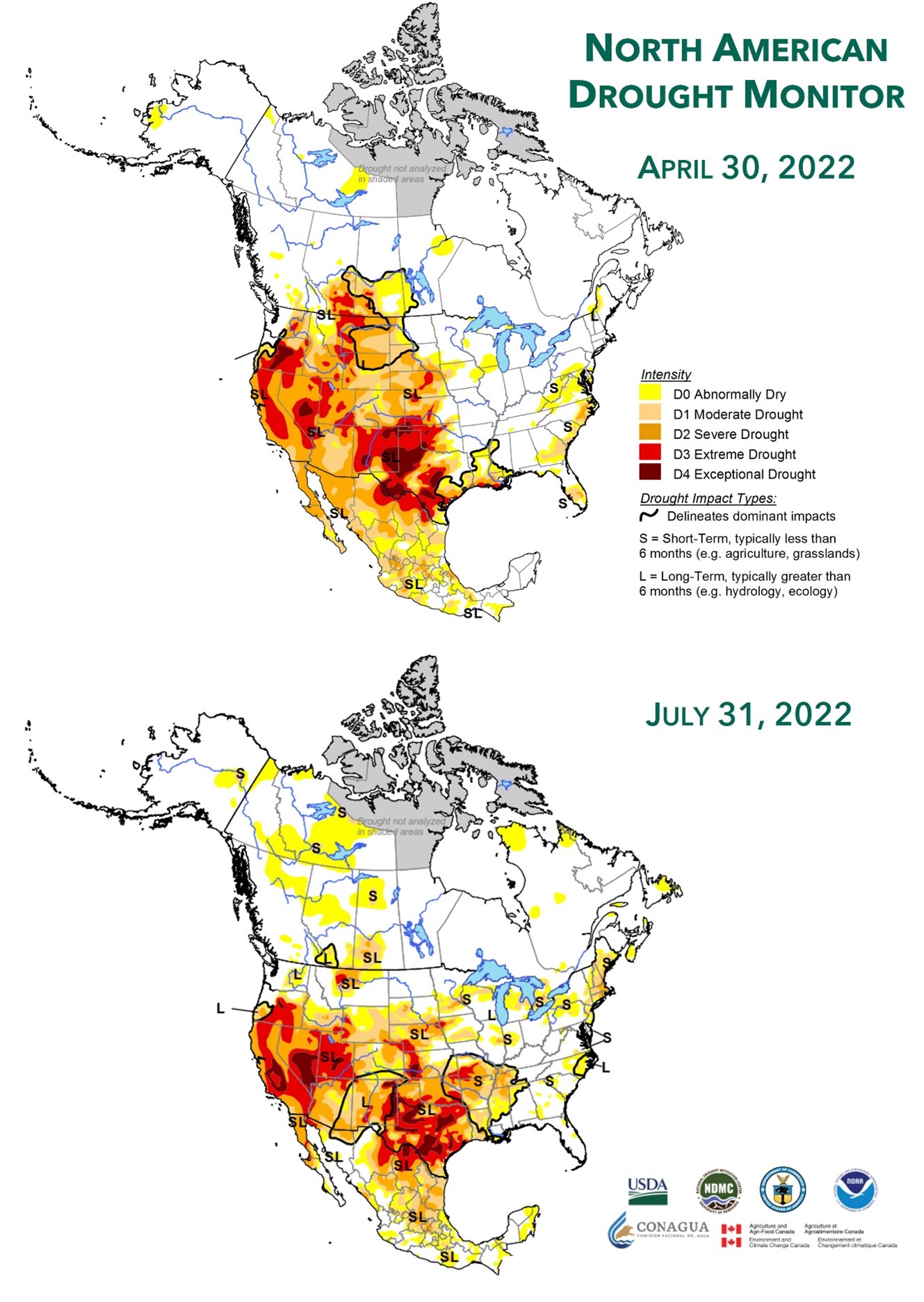
Figure 1. Status of drought in North America on April 30 and July 31, 2022. Maps from the North American Drought Monitoring program, https://www.ncdc.noaa.gov/temp-and-precip/drought/nadm.
Entering the 2022–23 waterfowl season, warm temperatures prevailed across much of the U.S., while occasional early season cold fronts stimulated teal migration and made hunters eager for cooler weather (Figure 2). The mild pattern continued into October, leading to lackluster bird movements, although a strong cold front around mid-month brought brief but record cold to portions of the eastern U.S. November ushered in major changes as Veteran's Day weekend brought sub-freezing temperatures to the Midcontinent, locking up wetlands in prairie Canada and triggering one of the more notable migrations in recent memory. Meanwhile, an early November winter storm brought cooler temperatures to the western U.S., with the Pacific Northwest experiencing its coldest November in nearly four decades. Temperatures remained frigid across the northern tier during December, while a series of storms brought periodic cold to southern states, punctuated by a major Arctic blast around Christmas that displaced birds to deeper waters and more southerly destinations. For some southern hunters, the exceptional cold and subsequent thaw produced excellent hunting, yet others found themselves frozen out of hunting spots with a rapid thaw failing to produce successful hunts. January brought the return of milder weather in the eastern U.S., eventually ranking as the 6th warmest on record nationwide, although a series of Pacific storms held temperatures in check across much of the West. Across the northeastern U.S., temperatures were abnormally warm across much of the season, making for stale ducks and slow hunting. Nationwide temperatures were generally mild during fall, while winter storms produced temporary bouts of weather favorable for triggering migration and causing birds to explore new habitats.
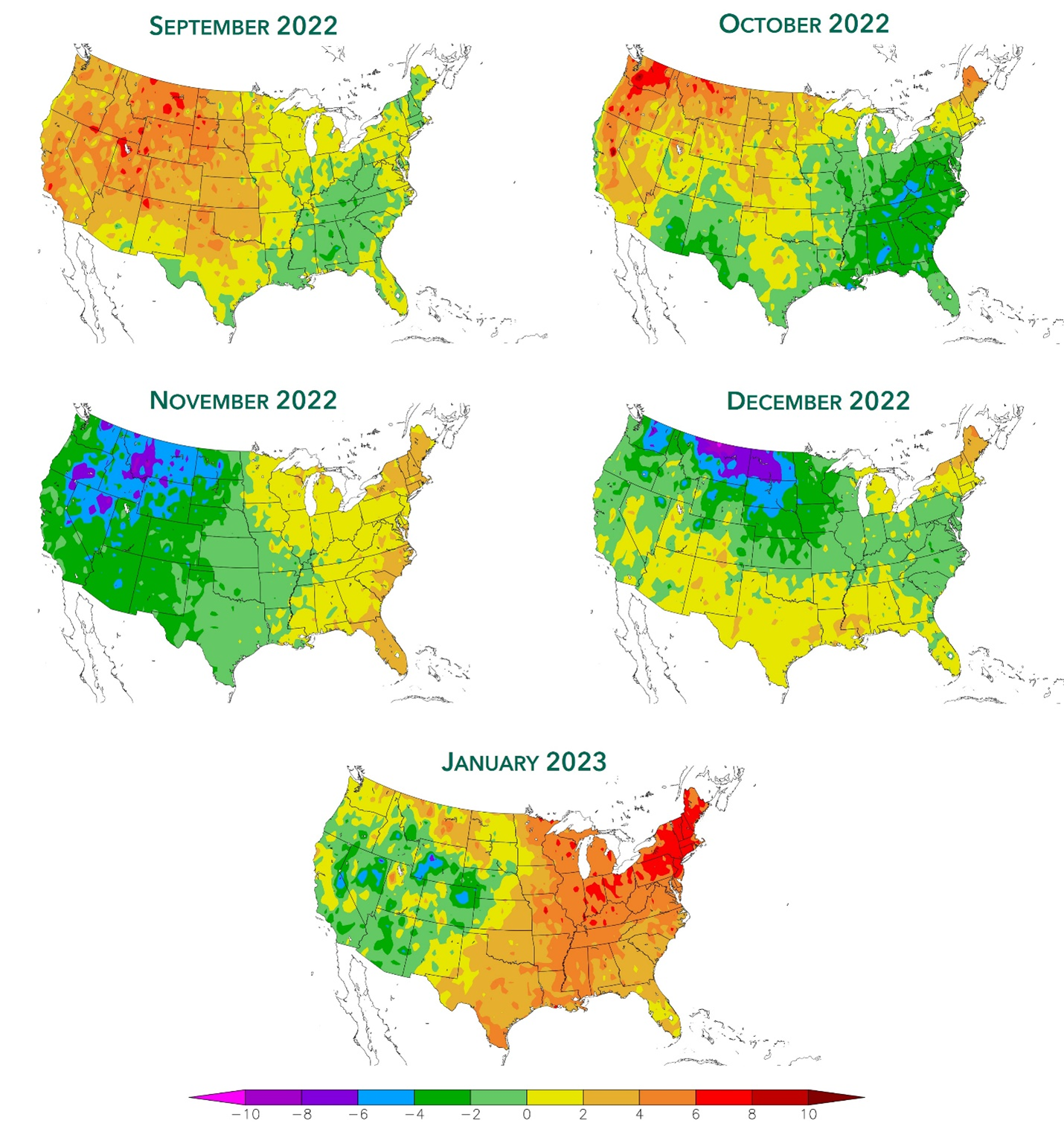
Figure 2. Average monthly temperature (°F) departure from normal for the contiguous U.S., Sep 2022–Jan 2023, https://hprcc.unl.edu/maps.php?map=ACISClimateMaps.
While temperature plays a significant role in the timing of waterfowl movements, the availability of water (i.e., habitat) can often have greater effects on bird distribution. Fall began with entrenched drought across the western U.S., Great Plains, and Lower Mississippi Valley, making for scarce habitat and limited hunting opportunities (Figures 1, 3, and 4). In the western U.S., multi-year drought and water restrictions resulted in the Lower Klamath NWR going dry for the first time in history, record low levels in the Great Salt Lake, and a 60% decrease in planted rice in the California Central Valley. In the Great Plains, Cheyenne Bottoms Wildlife Area was completely dry, and in Vicksburg, MS, the Mississippi River dropped to its lowest level in over a decade. As a result, hunters and land managers with access to quality habitat enjoyed success during teal and early duck season. As November rolled around, persistent drought and an early season Arctic blast created a worst-case scenario for hunters in the Southern Great Plains as migration accelerated through the Midcontinent in search of available habitat farther south. Hunters at the southern end of the flyway, including coastal Louisiana and Texas, appeared to be the beneficiaries, with many hunters reporting one of the best duck seasons in years. Drought conditions east of the Rockies began easing in late November, but it was December before additional habitats became widely available and hunters previously without adequate water found new opportunities. Welcome rain arrived in portions of the western U.S. in early November, but the big story came in December when 9 back-to-back Pacific storms between Christmas and mid-January produced record rain, feet of mountain snow, and deadly flooding for California. While the rain and snow helped alleviate long-term drought, in the short-term it curtailed opportunities for California hunters as high water precluded access to hunting destinations. Mild temperatures prevailed in January across the southcentral U.S., but frequent rains finally overcame the persistent drought and delivered overbank flooding that kept waterfowl on the move. On the east coast, a pair of hurricanes (Ian in September and Nicole in November) ravaged peninsular Florida and brought flooding rain during an otherwise dry fall-winter across the mid- and south-Atlantic coast.
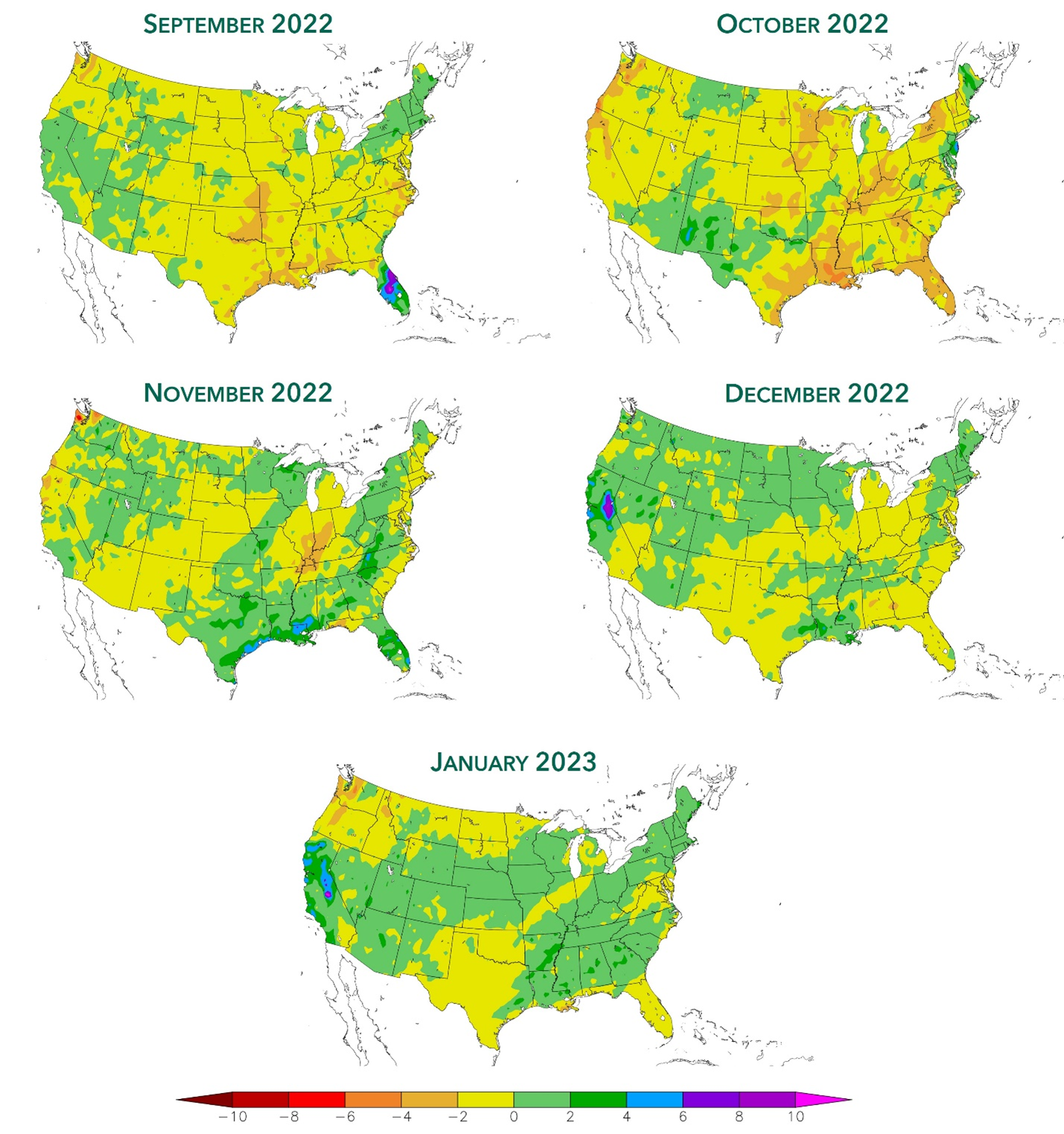
Figure 3. Total monthly precipitation (in), departure from normal for the contiguous U.S., Sep 2022–Jan 2023, https://hprcc.unl.edu/maps.php?map=ACISClimateMaps.
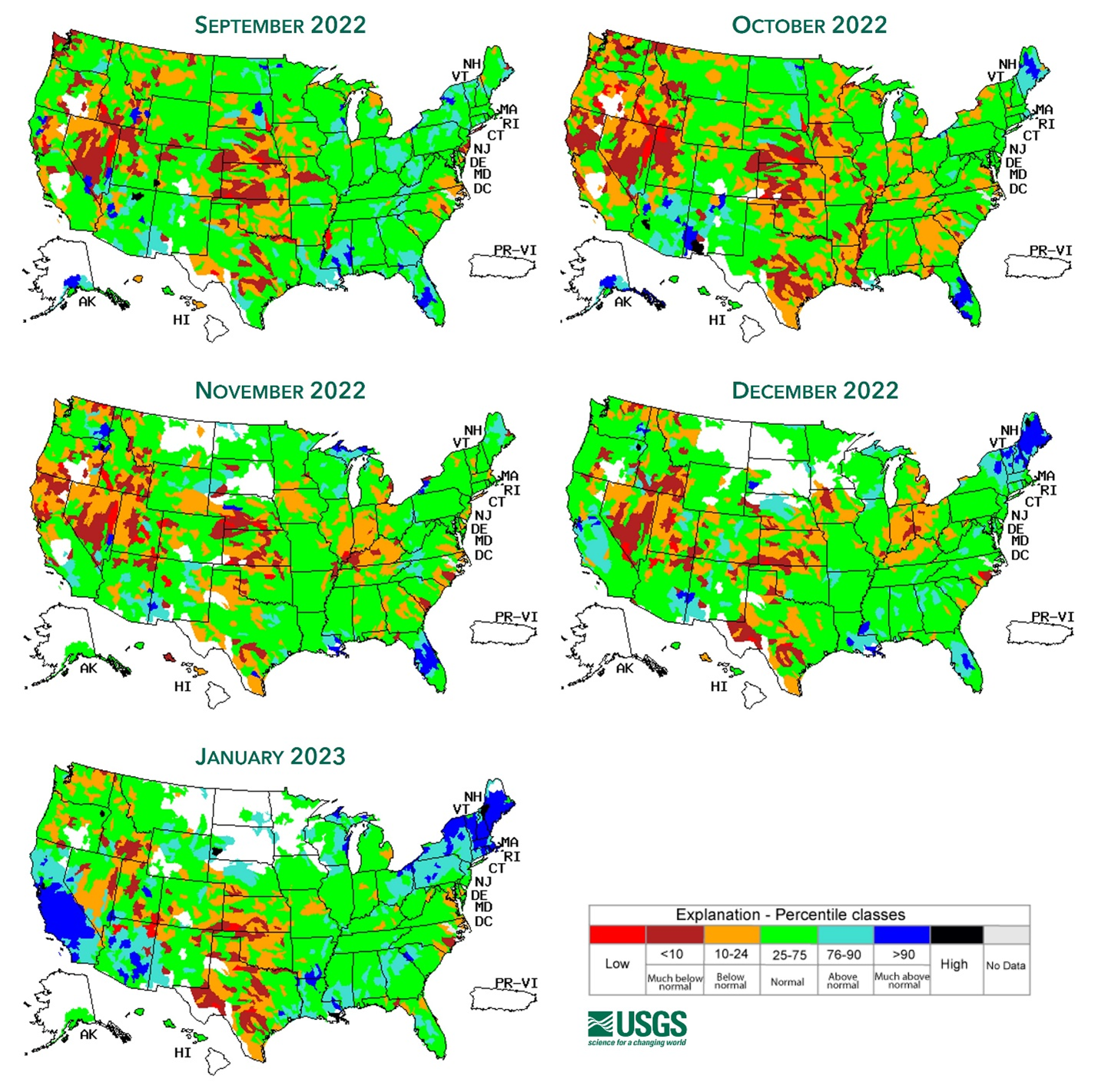
Figure 4. Monthly streamflow percentiles for the contiguous U.S., Sep 2022–Jan 2023, https://waterwatch.usgs.gov/index.php?ym=202201&m=nwc.
Snow and ice cover influence waterfowl by reducing access to critical resources, including residual grain from harvested crops or natural foods and roost sites in wetlands, rivers, and lakes. Snowfall during the 2022–23 season was concentrated in the northern Great Plains, high elevation areas of the western U.S., and the Great Lakes region (Figure 5). Although October storms brought record snowfall to portions of the western U.S. and Great Lakes, it failed to persist as warm temperatures soon returned. The first significant snowfall of the season came in November, bringing more than a foot of snow to the prairies and record lake-effect snow to portions of the Northeast. North and South Dakota saw their snowiest December on record, while a mid-December storm brought up to 2 feet of snow to portions of the northeastern U.S. In the West, atmospheric rivers in December and January continued to dump above-average mountain snow, boding well for spring snowmelt. In contrast, snow arrived late in the north Atlantic, as New York City established a new record by remaining snowless through January.
Ice cover on the Great Lakes tracked well below average across the entire season (Figure 6). Despite early season winter storms, temperatures in the Great Lakes region were largely above average, and strong winds combined to prevent major ice formation. Although ice began to cover bays and shallow waters in late December, the return of warm temperatures in January saw it quickly dissipate. By January 15, cumulative ice cover across the Great Lakes was 70% below average. Sustained open water on Lake St Clair, Lake Erie, Lake Huron, and other bays and protected areas allowed species such as redheads and scaup to utilize northern waters in astounding numbers throughout the season. Limited migration out of these areas likely affected bird abundance and hunter success in other traditional wintering sites.
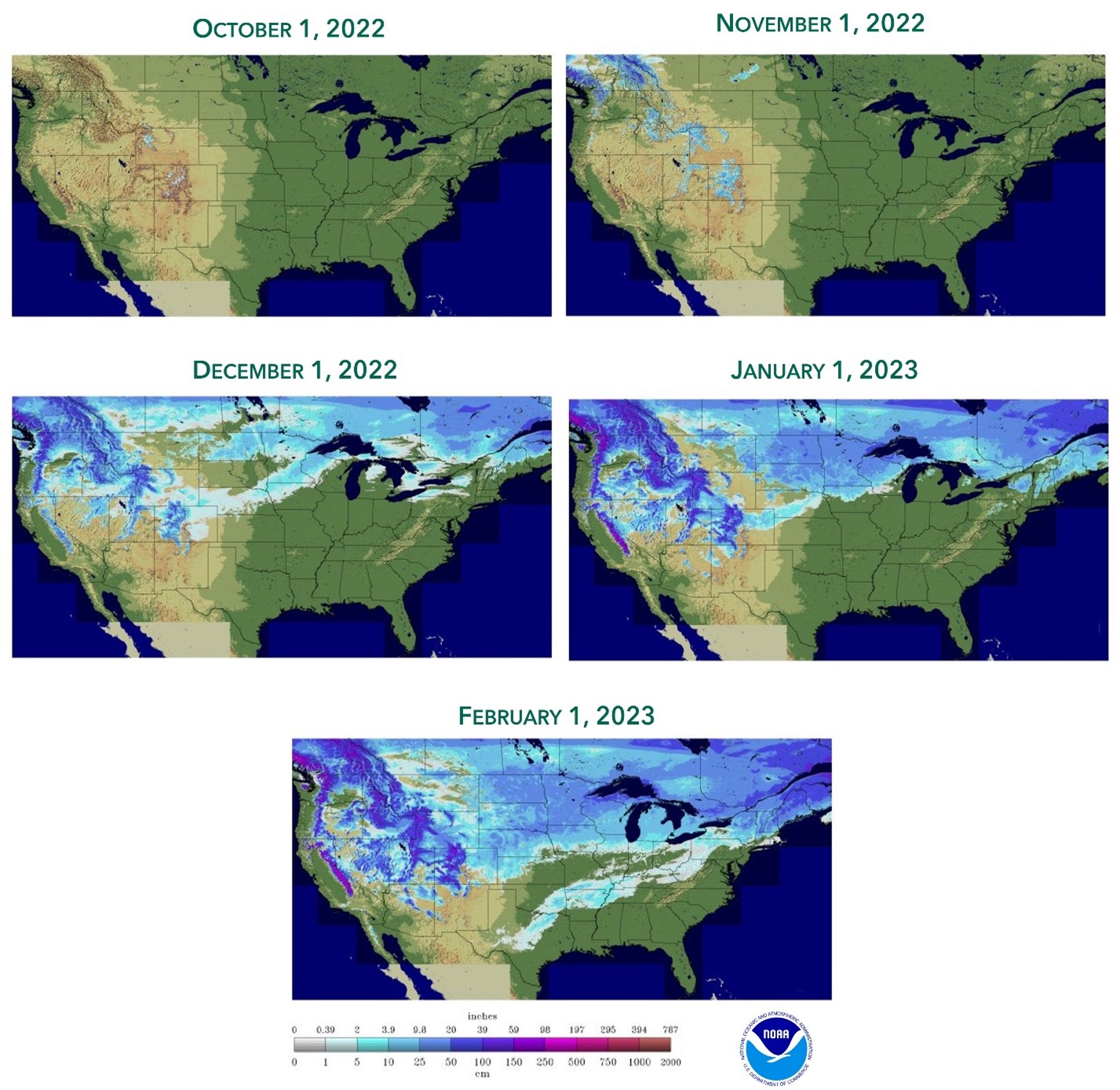
Figure 5. Daily snow depth (in) on the first day of each month, Oct 2022–Feb 2023, for the contiguous U.S., https://www.nohrsc.noaa.gov/nsa/.
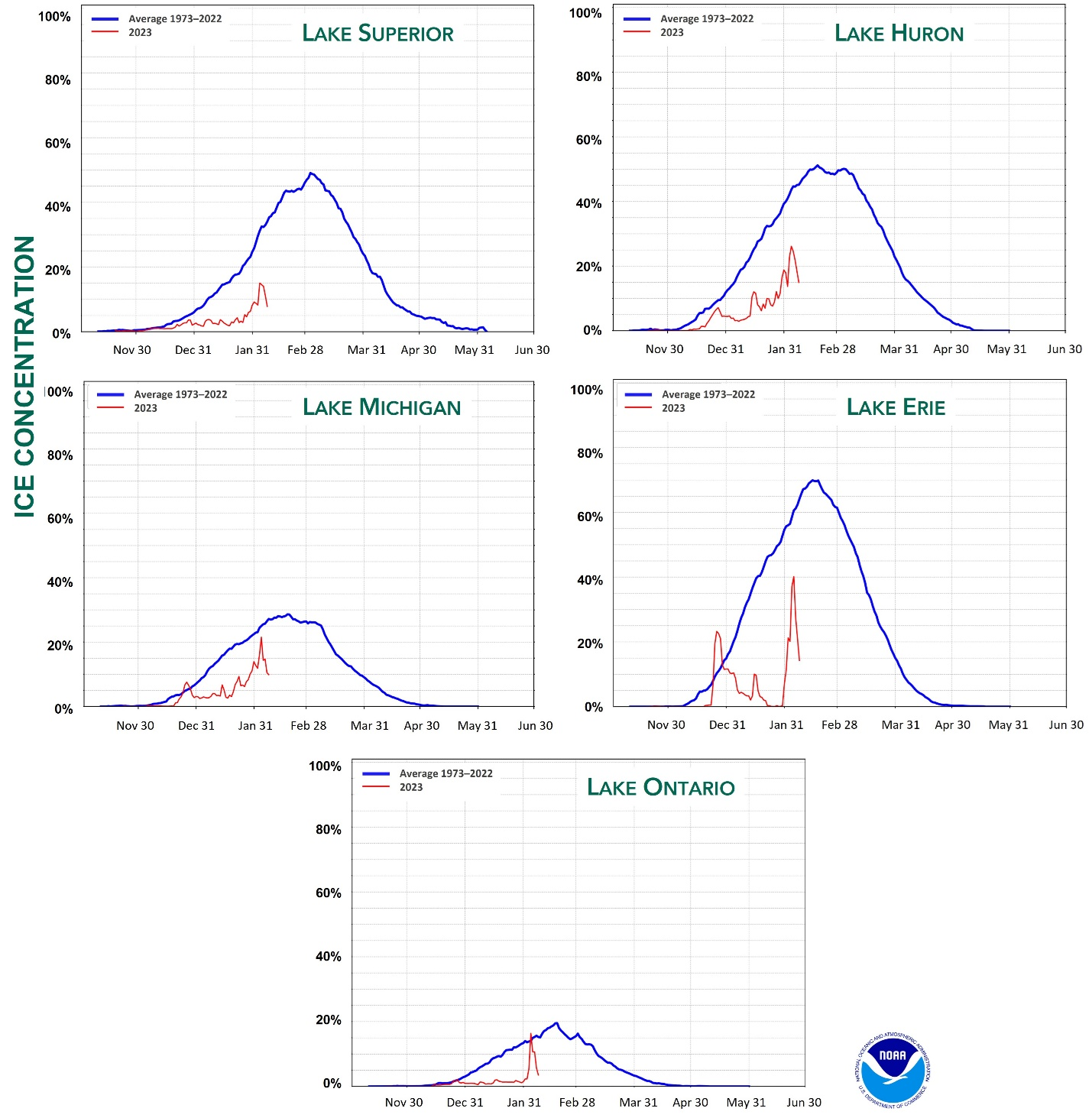
Figure 6. Winter pattern of long-term (1973–2022) average ice cover (%) on the Great Lakes, compared to current year, as of Feb 8, 2023. https://coastwatch.glerl.noaa.gov/statistic/statistic.html
As fall unfolded, avian flu emerged as perhaps the most discussed issue among waterfowl hunters and managers. In early November, DU staff began receiving reports of sick or dead waterfowl across multiple states, sometimes in large numbers. Discussions with state and federal partners revealed additional such observations, and testing from wildlife disease labs confirmed highly pathogenic avian influenza (HPAI) as the primary cause. The outbreak was the result of a new strain of HPAI (H5N1) that was first detected in the U.S. in January 2022. While waterfowl typically show few effects from avian influenza, wildlife disease experts agree that the current strain is causing unusually high amounts of illness and death. Surveillance efforts by state and federal partners documented live HPAI virus in many different species of ducks and geese, although snow, Ross's, and Canada geese were the species most affected with illness or mortality. In addition, juvenile birds appeared to be more susceptible due to their naïve immune systems. Waterfowl managers are unsure how long the current outbreak will last or what its overall impacts will be, although they generally do not expect long-term consequences for wild waterfowl populations. Results from a small number of blood samples collected during winter indicated prevalence of circulating antibodies for H5 avian flu viruses in many birds, suggesting the potential for bird populations to develop protection against future infection. Whether the virus will persist and have similar or more severe impacts on bird populations in fall of 2023 remains unknown. In the meantime, people are advised to continue reporting sick or dead birds to state wildlife agencies and take precautions to limit the spread into backyard flocks and commercial facilities. More information on avian flu, including how DU is responding and guidance for hunters, can be found at www.ducks.org/avianflu.
Following dramatic recovery of wetland conditions in the U.S. prairies in spring 2022, and in light of generally good wetland conditions in Alaska and the boreal forest, waterfowl managers expected greater production and more young birds in the fall flight. Anecdotal reports seemed to corroborate this expectation, although exceptions were noted in areas where lingering drought suppressed local production. Exceptional drought in the West eventually gave way to torrential rain and record mountain snow, which in the short-term improved conditions for waterfowl and hunters, but later caused widespread flooding and closed access to hunting locations. Drought across the Midcontinent, coupled with timely arrival of winter storms, produced notable migrations and provided southern hunters with one of their better seasons in recent memory, at least for those with access to huntable water. In contrast, persistent warmth in the Atlantic flyway and lack of ice on the Great Lakes made for slow hunting overall in the eastern U.S., although late-season winter storms enabled periodic success. Drought in the Mississippi Alluvial Valley eased through December and January as frequent rains inundated new habitats and created fresh opportunities for hunters that had limited options earlier in the season. Hunters in the Southern Great Plains encountered some of the most challenging conditions, as entrenched drought and a rapid, early season migration led to few ducks and even less water. From September hurricanes to November freezes and January atmospheric rivers, the 2022–23 season was characterized by significant weather events that had notable impacts on movements of waterfowl, availability of habitats, and opportunities for hunting. Although hunters in some regions found themselves with limited success, most managers and hunters described the 2022–23 season as "average" or "slightly better than average," owing to greater production in 2022 and weather systems that kept birds and hunters on the move.
Looking forward to spring 2023 breeding habitat conditions, the prairies of southwestern Manitoba and southeastern Saskatchewan continue to show beneficial effects of abundant moisture and healthy wetlands in 2022. Drier conditions prevail westward into Alberta and northern Montana and will require additional late-winter or spring moisture for substantial improvement. Abundant snow in portions of the Dakotas has the U.S. prairies primed for another year of good production, although additional moisture will be needed to sustain wetlands for brood habitat and late-nesting ducks. Despite generally lower than average precipitation in the western boreal forest, wetland conditions of important breeding landscapes in Alaska and the Canadian boreal forest should again produce a stable supply of young ducks. Winter rains and mountain snow eased the western drought, boosted lake levels, and improved prospects for local duck production for the first time in many years. However, improved rain and snow totals will be needed over an extended period of time to fully recover critically important waterfowl habitats from the ongoing multi-year drought.
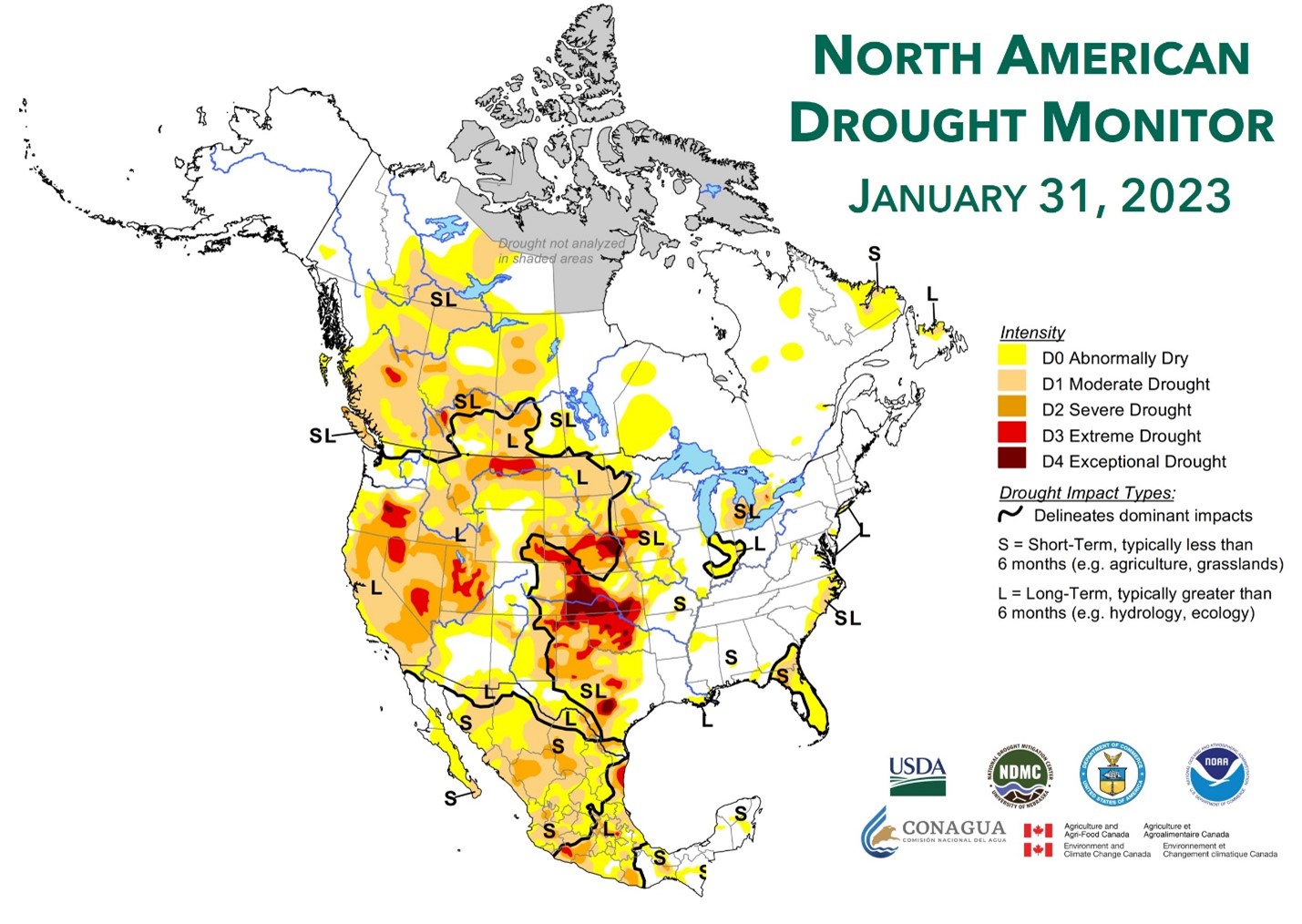
Figure 7. Status of drought in North America on January 31, 2023. Maps from the North American Drought Monitoring program, https://www.ncdc.noaa.gov/temp-and-precip/drought/nadm.
Download a PDF of Season in Review 2022-23
Ducks Unlimited uses cookies to enhance your browsing experience, optimize site functionality, analyze traffic, and deliver personalized advertising through third parties. By continuing to use this site, you agree to our use of cookies. View Privacy Policy